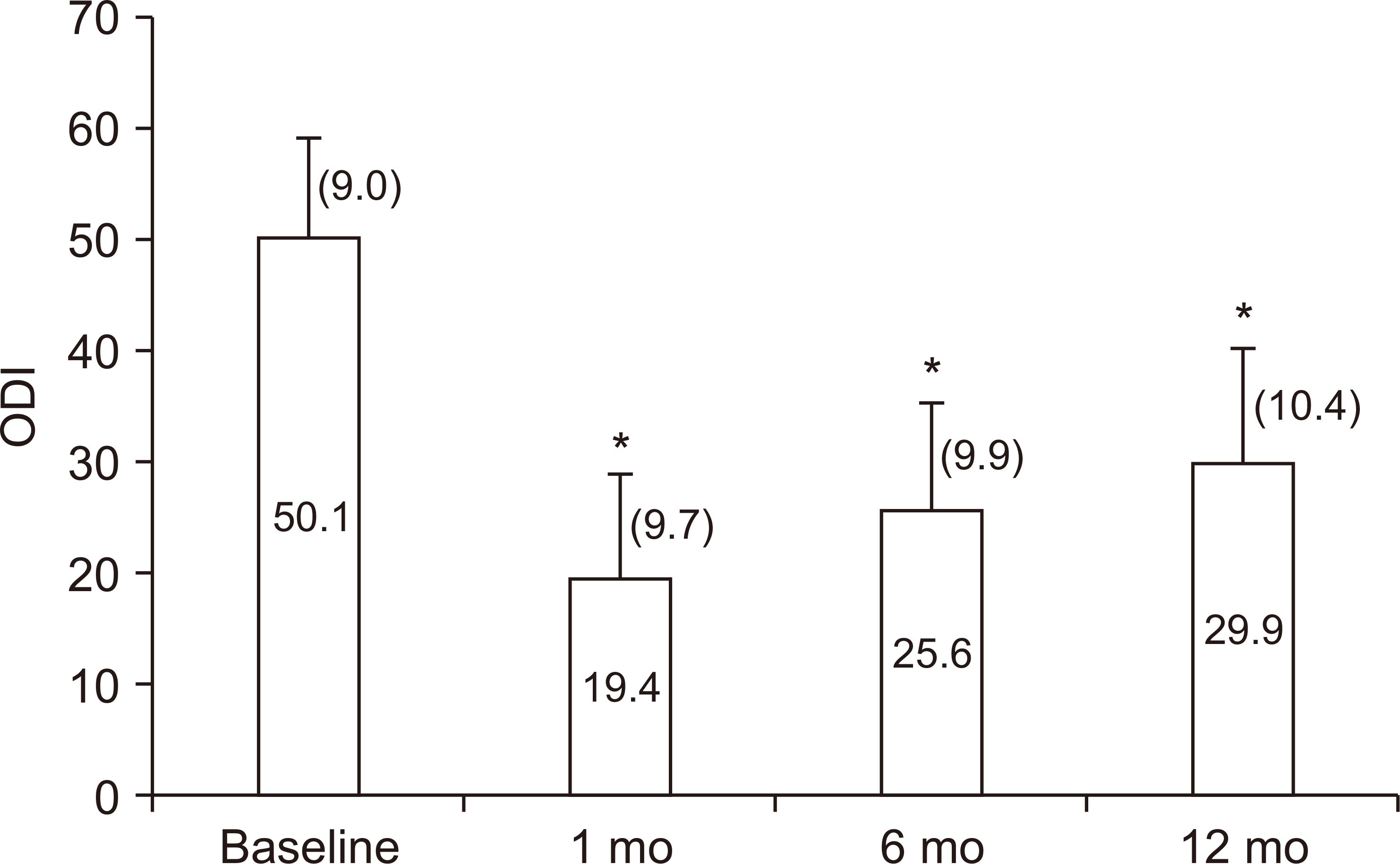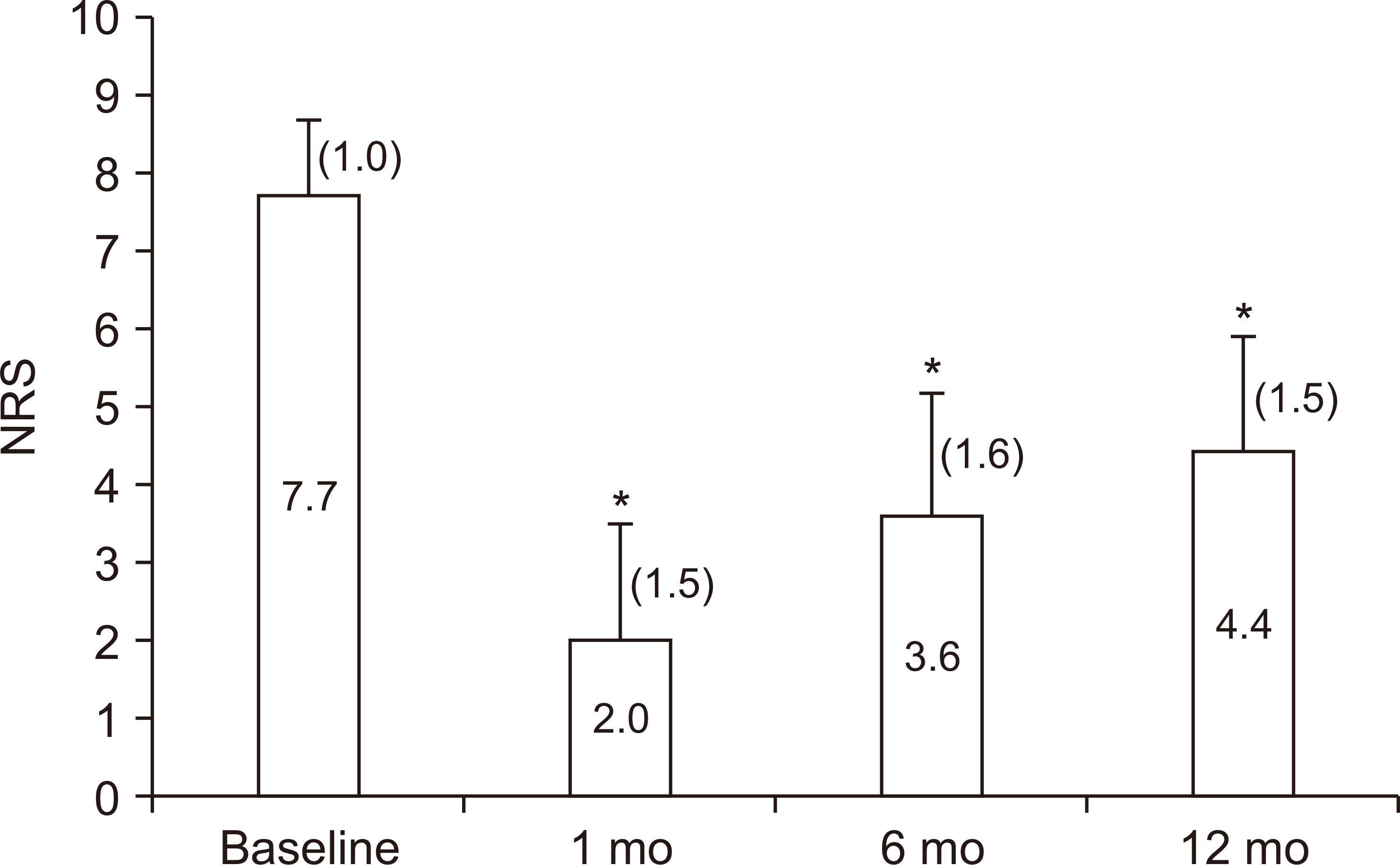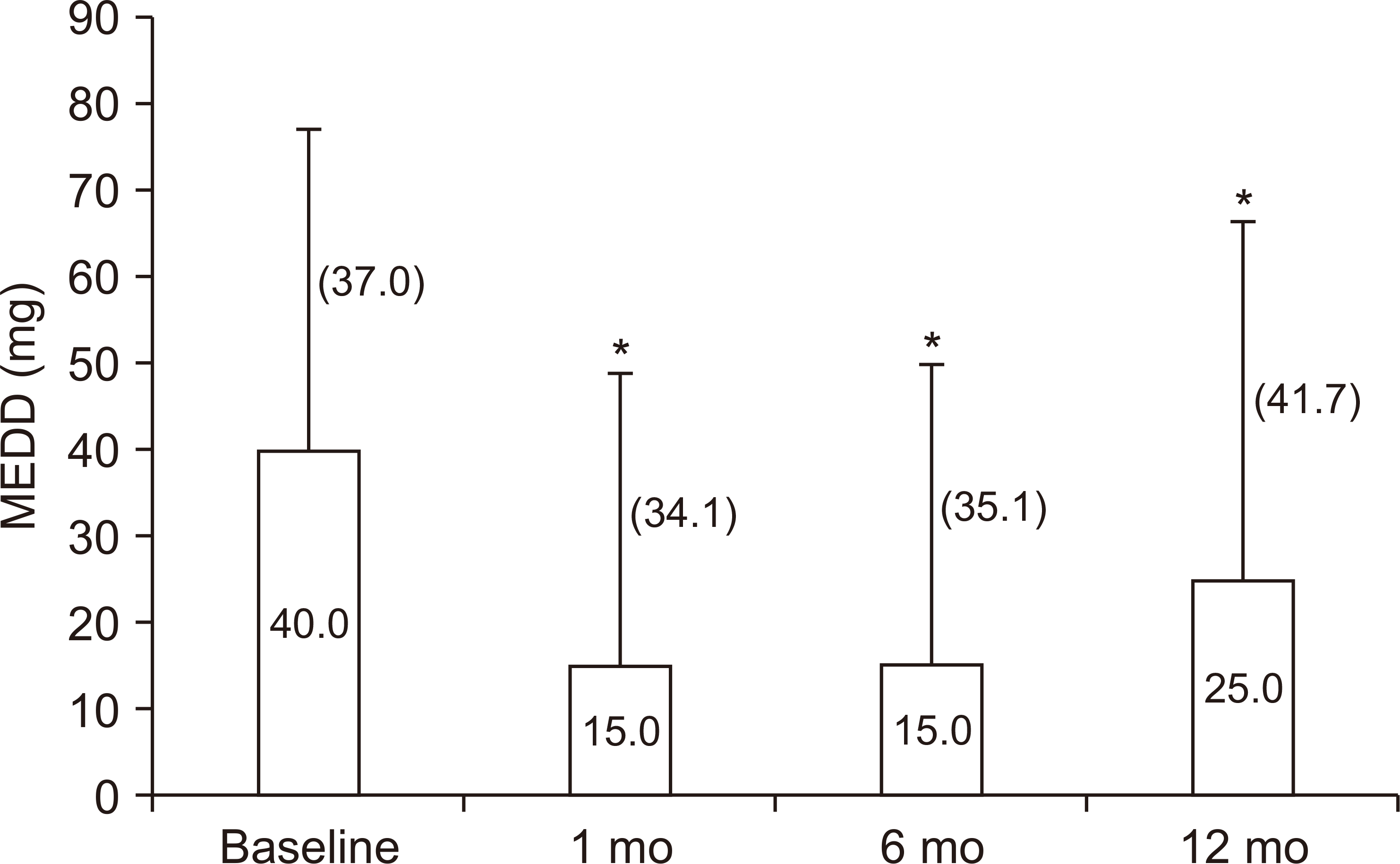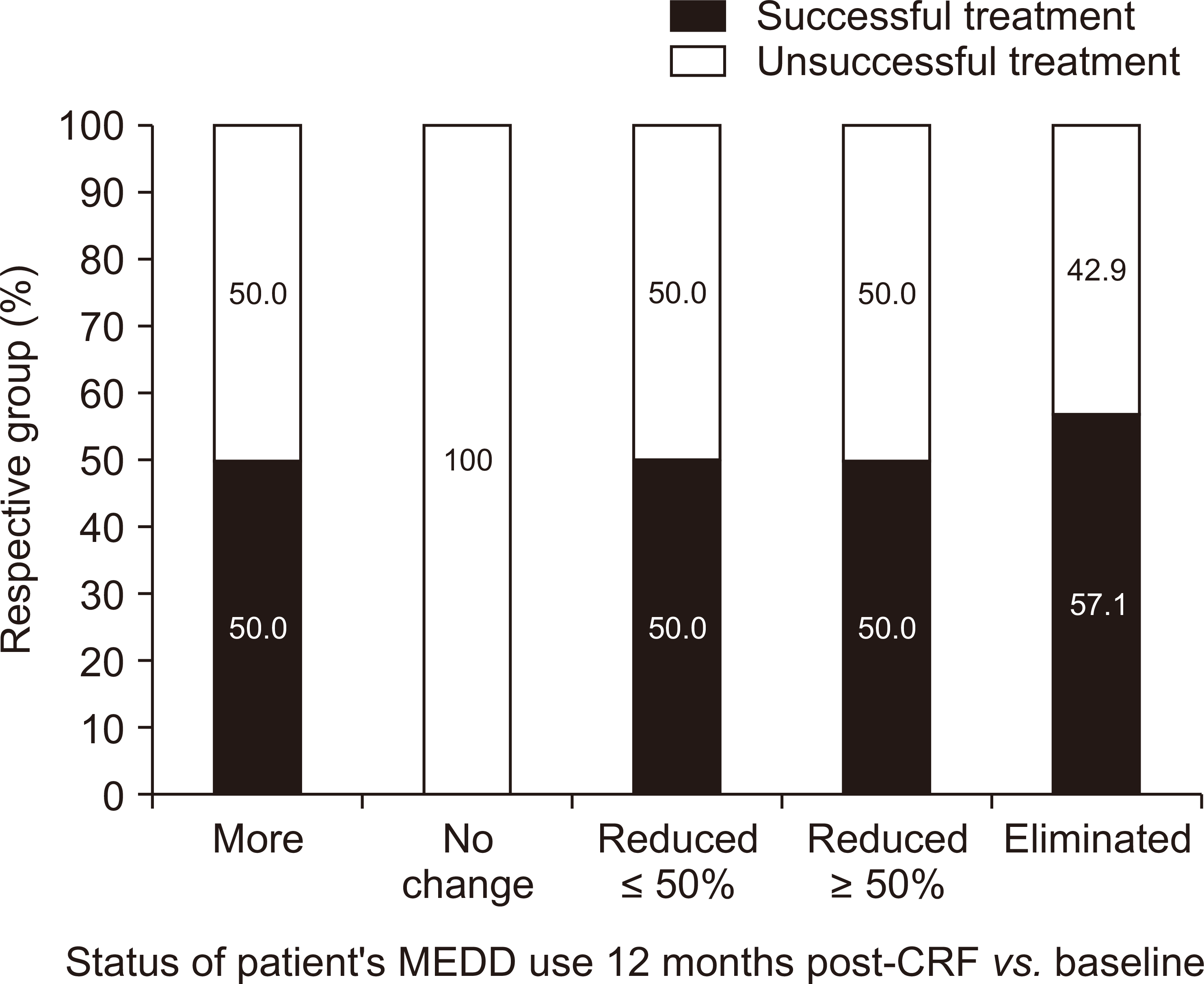3. Hansen H, Manchikanti L, Simopoulos TT, Christo PJ, Gupta S, Smith HS, et al. 2012; A systematic evaluation of the therapeutic effectiveness of sacroiliac joint interventions. Pain Physician. 15:E247–78. PMID:
22622913.
4. Simopoulos TT, Manchikanti L, Gupta S, Aydin SM, Kim CH, Solanki D, et al. 2015; Systematic review of the diagnostic accuracy and therapeutic effectiveness of sacroiliac joint interventions. Pain Physician. 18:E713–56. PMID:
26431129.
5. Lee JD, Lee DW, Jeong CW, Lee HG, Yoon MH, Kim WM. 2009; Effects of intraarticular prolotherapy on sacroiliac joint pain. Korean J Pain. 22:229–33. DOI:
10.3344/kjp.2009.22.3.229.

6. Kuijpers T, van Middelkoop M, Rubinstein SM, Ostelo R, Verhagen A, Koes BW, et al. 2011; A systematic review on the effectiveness of pharmacological interventions for chronic non-specific low-back pain. Eur Spine J. 20:40–50. DOI:
10.1007/s00586-010-1541-4. PMID:
20680369. PMCID:
PMC3036024.

7. Garcia AN, Costa LDCM, Hancock MJ, Souza FS, Gomes GVFO, Almeida MO, et al. 2018; McKenzie method of mechanical diagnosis and therapy was slightly more effective than placebo for pain, but not for disability, in patients with chronic non-specific low back pain: a randomised placebo controlled trial with short and longer term follow-up. Br J Sports Med. 52:594–600. DOI:
10.1136/bjsports-2016-097327. PMID:
28701365.

8. Spiker WR, Lawrence BD, Raich AL, Skelly AC, Brodke DS. 2012; Surgical versus injection treatment for injection-confirmed chronic sacroiliac joint pain. Evid Based Spine Care J. 3:41–53. DOI:
10.1055/s-0032-1328142. PMID:
23526911. PMCID:
PMC3592770.

9. Trang T, Al-Hasani R, Salvemini D, Salter MW, Gutstein H, Cahill CM. 2015; Pain and poppies: the good, the bad, and the ugly of opioid analgesics. J Neurosci. 35:13879–88. DOI:
10.1523/JNEUROSCI.2711-15.2015. PMID:
26468188. PMCID:
PMC4604226.

13. Rudd RA, Seth P, David F, Scholl L. 2016; Increases in drug and opioid-involved overdose deaths - United States, 2010-2015. MMWR Morb Mortal Wkly Rep. 65:1445–52. DOI:
10.15585/mmwr.mm655051e1. PMID:
28033313.

14. Florence CS, Zhou C, Luo F, Xu L. 2016; The economic burden of prescription opioid overdose, abuse, and dependence in the United States, 2013. Med Care. 54:901–6. DOI:
10.1097/MLR.0000000000000625. PMID:
27623005. PMCID:
PMC5975355.

15. Vowles KE, McEntee ML, Julnes PS, Frohe T, Ney JP, van der Goes DN. 2015; Rates of opioid misuse, abuse, and addiction in chronic pain: a systematic review and data synthesis. Pain. 156:569–76. DOI:
10.1097/01.j.pain.0000460357.01998.f1. PMID:
25785523.
16. Muhuri PK, Gfroerer JC, Davies MC. 2013; Associations of nonmedical pain reliever use and initiation of heroin use in the United States. CBHSQ Data Rev. 8:1–17.
17. Cicero TJ, Ellis MS, Surratt HL, Kurtz SP. 2014; The changing face of heroin use in the United States: a retrospective analysis of the past 50 years. JAMA Psychiatry. 71:821–6. DOI:
10.1001/jamapsychiatry.2014.366. PMID:
24871348.

18. Carlson RG, Nahhas RW, Martins SS, Daniulaityte R. 2016; Predictors of transition to heroin use among initially non-opioid dependent illicit pharmaceutical opioid users: a natural history study. Drug Alcohol Depend. 160:127–34. DOI:
10.1016/j.drugalcdep.2015.12.026. PMID:
26785634. PMCID:
PMC4767561.

19. Ramasubba C, Cohen SP. 2013; Cooled sacroiliac radiofrequency denervation for the treatment of pain secondary to tumor infiltration: a case-based focused literature review. Pain Physician. 16:1–8. PMID:
23340529.
20. Kapural L, Nageeb F, Kapural M, Cata JP, Narouze S, Mekhail N. 2008; Cooled radiofrequency system for the treatment of chronic pain from sacroiliitis: the first case-series. Pain Pract. 8:348–54. DOI:
10.1111/j.1533-2500.2008.00231.x. PMID:
18844853.

21. Cohen SP, Strassels SA, Kurihara C, Crooks MT, Erdek MA, Forsythe A, et al. 2009; Outcome predictors for sacroiliac joint (lateral branch) radiofrequency denervation. Reg Anesth Pain Med. 34:206–14. DOI:
10.1097/AAP.0b013e3181958f4b. PMID:
19587617.

22. Stelzer W, Aiglesberger M, Stelzer D, Stelzer V. 2013; Use of cooled radiofrequency lateral branch neurotomy for the treatment of sacroiliac joint-mediated low back pain: a large case series. Pain Med. 14:29–35. DOI:
10.1111/pme.12014. PMID:
23279364.

23. Stelzer W, Stelzer V, Stelzer D, Braune M, Duller C. 2017; Influence of BMI, gender, and sports on pain decrease and medication usage after facet-medial branch neurotomy or SI joint lateral branch cooled RF-neurotomy in case of low back pain: original research in the Austrian population. J Pain Res. 10:183–90. DOI:
10.2147/JPR.S121897. PMID:
28144161. PMCID:
PMC5245915.
24. Tinnirello A, Barbieri S, Todeschini M, Marchesini M. 2017; Conventional (Simplicity III) and cooled (SInergy) radiofrequency for sacroiliac joint denervation: one-year retrospective study comparing two devices. Pain Med. 18:1731–44. DOI:
10.1093/pm/pnw333. PMID:
28340063.

25. Cohen SP, Chen Y, Neufeld NJ. 2013; Sacroiliac joint pain: a comprehensive review of epidemiology, diagnosis and treatment. Expert Rev Neurother. 13:99–116. DOI:
10.1586/ern.12.148. PMID:
23253394.

26. Laslett M, Aprill CN, McDonald B, Young SB. 2005; Diagnosis of sacroiliac joint pain: validity of individual provocation tests and composites of tests. Man Ther. 10:207–18. DOI:
10.1016/j.math.2005.01.003. PMID:
16038856.

27. Szadek KM, van der Wurff P, van Tulder MW, Zuurmond WW, Perez RS. 2009; Diagnostic validity of criteria for sacroiliac joint pain: a systematic review. J Pain. 10:354–68. DOI:
10.1016/j.jpain.2008.09.014. PMID:
19101212.

28. Hegarty D. 2016; Clinical outcome following radiofrequency denervation for refractory sacroiliac joint dysfunction using the Simplicity III probe: a 12-month retrospective evaluation. Pain Physician. 19:E129–35. PMID:
26752481.
29. Bellini M, Barbieri M. 2016; Single strip lesions radiofrequency denervation for treatment of sacroiliac joint pain: two years’ results. Anaesthesiol Intensive Ther. 48:19–22. DOI:
10.5603/AIT.2016.0004. PMID:
26966108.

30. Ho KY, Hadi MA, Pasutharnchat K, Tan KH. 2013; Cooled radiofrequency denervation for treatment of sacroiliac joint pain: two-year results from 20 cases. J Pain Res. 6:505–11. DOI:
10.2147/JPR.S46827. PMID:
23869175. PMCID:
PMC3706381.

31. Cohen SP, Hurley RW, Buckenmaier CC 3rd, Kurihara C, Morlando B, Dragovich A. 2008; Randomized placebo-controlled study evaluating lateral branch radiofrequency denervation for sacroiliac joint pain. Anesthesiology. 109:279–88. DOI:
10.1097/ALN.0b013e31817f4c7c. PMID:
18648237. PMCID:
PMC2666931.

32. Franklin G, Sabel J, Jones CM, Mai J, Baumgartner C, Banta-Green CJ, et al. 2015; A comprehensive approach to address the prescription opioid epidemic in Washington state: milestones and lessons learned. Am J Public Health. 105:463–9. DOI:
10.2105/AJPH.2014.302367. PMID:
25602880. PMCID:
PMC4330848.

33. Farrar JT, Young JP Jr, LaMoreaux L, Werth JL, Poole RM. 2001; Clinical importance of changes in chronic pain intensity measured on an 11-point numerical pain rating scale. Pain. 94:149–58. DOI:
10.1016/S0304-3959(01)00349-9. PMID:
11690728.

34. Dworkin RH, Turk DC, Wyrwich KW, Beaton D, Cleeland CS, Farrar JT, et al. 2008; Interpreting the clinical importance of treatment outcomes in chronic pain clinical trials: IMMPACT recommendations. J Pain. 9:105–21. DOI:
10.1016/j.jpain.2007.09.005. PMID:
18055266.
37. Al-Khayer A, Hegarty J, Hahn D, Grevitt MP. 2008; Percutaneous sacroiliac joint arthrodesis: a novel technique. J Spinal Disord Tech. 21:359–63. DOI:
10.1097/BSD.0b013e318145ab96. PMID:
18600147.
38. Buchowski JM, Kebaish KM, Sinkov V, Cohen DB, Sieber AN, Kostuik JP. 2005; Functional and radiographic outcome of sacroiliac arthrodesis for the disorders of the sacroiliac joint. Spine J. 5:520–8. DOI:
10.1016/j.spinee.2005.02.022. PMID:
16153580.

39. Waisbrod H, Krainick JU, Gerbershagen HU. 1987; Sacroiliac joint arthrodesis for chronic lower back pain. Arch Orthop Trauma Surg. 106:238–40. DOI:
10.1007/BF00450461. PMID:
2956935.

40. Schütz U, Grob D. 2006; Poor outcome following bilateral sacroiliac joint fusion for degenerative sacroiliac joint syndrome. Acta Orthop Belg. 72:296–308. PMID:
16889141.
41. Wise CL, Dall BE. 2008; Minimally invasive sacroiliac arthrodesis: outcomes of a new technique. J Spinal Disord Tech. 21:579–84. DOI:
10.1097/BSD.0b013e31815ecc4b. PMID:
19057252.
42. Ashman B, Norvell DC, Hermsmeyer JT. 2010; Chronic sacroiliac joint pain: fusion versus denervation as treatment options. Evid Based Spine Care J. 1:35–44. DOI:
10.1055/s-0030-1267066. PMID:
22956926. PMCID:
PMC3427958.

43. Watanabe I, Masaki R, Min N, Oshikawa N, Okubo K, Sugimura H, et al. 2002; Cooled-tip ablation results in increased radiofrequency power delivery and lesion size in the canine heart: importance of catheter-tip temperature monitoring for prevention of popping and impedance rise. J Interv Card Electrophysiol. 6:9–16. DOI:
10.1023/A:1014140104777. PMID:
11839878.
44. Roberts SL, Burnham RS, Ravichandiran K, Agur AM, Loh EY. 2014; Cadaveric study of sacroiliac joint innervation: implications for diagnostic blocks and radiofrequency ablation. Reg Anesth Pain Med. 39:456–64. DOI:
10.1097/AAP.0000000000000156. PMID:
25304483.
45. Cox RC, Fortin JD. 2014; The anatomy of the lateral branches of the sacral dorsal rami: implications for radiofrequency ablation. Pain Physician. 17:459–64. PMID:
25247902.
47. Chaparro LE, Furlan AD, Deshpande A, Mailis-Gagnon A, Atlas S, Turk DC. 2013; Opioids compared to placebo or other treatments for chronic low-back pain. Cochrane Database Syst Rev. (8):CD004959. DOI:
10.1002/14651858.CD004959.pub4. PMID:
23983011.






 PDF
PDF Citation
Citation Print
Print







 XML Download
XML Download